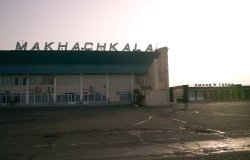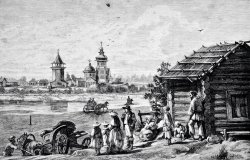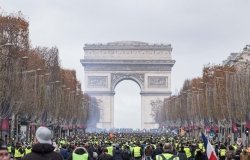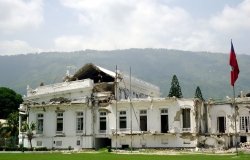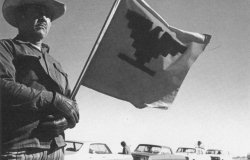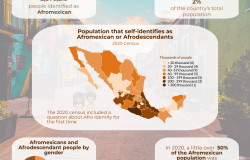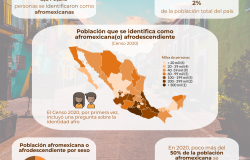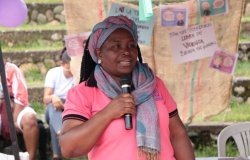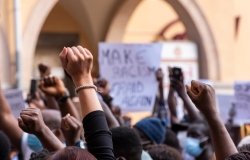318. Representing Competing Entities in Postwar Mostar
Emily Gunzburger Makas is a PhD Candidate in History of Architecture and Urbanism at Cornell University. She spoke at an EES Noon Discussion November 16, 2005. The following is a summary of her presentation. Meeting Report 318
Mostar was the most heavily damaged city of the 1992 to 1995 war in Bosnia. Ninety percent of its center was damaged and a third of its buildings were completely destroyed. Thousands were killed and tens of thousands were displaced from their homes and from the city, while tens of thousands of others moved to Mostar. This physical and demographic change clearly affected the city's postwar climate. However, the war's most notorious legacy in Mostar is the city's political and psychological division into Croat and Muslim sides.
Throughout this decade of division, and to an extent still today despite political reunification in March 2004, tendencies toward reuniting the city and its population have conflicted with tendencies towards consolidating their separation. This tension mirrors Bosnia's general identity debates in which various, distinct nationalisms compete for the ‘hearts and minds' of the Bosnian population as well as for spaces and sites within the country. Bosnia's possible multiculturalism has been at odds with the particular identities of its three constituent peoples—the Serbs, Croats and Muslims—and the idea of shared space has been at odds with the territorialization of identities.
These struggles have been consciously and unconsciously articulated in Mostar through the rebuilding of destroyed heritage and the construction of new buildings and monuments. Studying the controversies surrounding the meanings of specific projects in Mostar reveals that elements of both unifying and divisive tendencies are present in many projects, including the New Old Bridge, the city's most well known site.
Postwar Projects
In July 2005 UNESCO inscribed Mostar's Old Town and newly reconstructed Old Bridge on the World Heritage List because it is "an exceptional and universal symbol of coexistence." In July 2004 the New Old Bridge was ceremoniously opened in front of local, regional and world leaders and High Representative Paddy Ashdown declared that its reconstruction symbolized "knitting together communities so recently torn apart." These high profile statements about the symbolism of Mostar and its bridge echo interpretations articulated by countless journalists, passers-by, politicians and international organizations in the past decade, who have ubiquitously argued the Old Bridge and its city represent multiculturalism and reconciliation.
These new symbolisms raise serious concerns since the basic underlying assumptions on which they are based are themselves problematic. Before its destruction, no one discussed the bridge as a symbol of Bosnian multiculturalism and before the war no one talked about it as a potential site of reconciliation. It is not clear if the multiculturalism the Old Bridge is said to represent really exists or if the reconciliation its reconstruction is said to symbolize is actually occurring.
The Old Bridge was not reconstructed in isolation and the complexities of its meanings cannot be understood without taking into consideration its urban context. By exploring other postwar projects damaged in Mostar the competition between identities and between divisive and unifying tendencies in the city becomes clear.
The package of grants and loans organized by the World Bank which funded the bridge's reconstruction also provided funding for work at additional sites within the city. In the past year these have been used for the restoration of the Serb Orthodox Metropolitan's Palace, the Croat Cultural Center Napredak, and the Islamic Community's Vakuf Palace. These three turn-of-the-century buildings were selected to cover the range of confessional and national affiliations in Mostar and Bosnia. However, by singling out sites and associating them with separate groups within the Bosnian population, this initiative highlights their differences. By restoring a project for each, the international community is indicating that there is no Bosnian collective and that each group must be addressed individually.
One of the most prominent and most contested recent architectural projects in Mostar is the reconstructed Franciscan Church. After the war, the badly damaged church was cleared from its site and in its place was erected a slightly larger church with a dramatically taller bell tower. Supporters and critics agree that the tower's primary effect is to clearly mark a Croat Catholic presence on the city's skyline. For the Franciscans and most of the city's Catholic Croats, this is a celebration of their identity made visible. But others see this bell tower as reinforcing the line of separation that marks the beginning of "Croat" territory due to its location along the dividing boulevard. Not only are aesthetic sensibilities offended by its blatant disregard for the scale of the neighborhood and the church itself, but the tower's height is also viewed as aggressive and confrontational.
Looking closely at arguments in favor of the tower reveals something about the complexity of shared cities and of the multiple ways of understanding multiculturalism. Its supporters believe that it is "proof of the power of coexistence and multi-ethnicity in Mostar" not because it is a shared space or symbol like the Old Bridge allegedly is, but because its presence alongside symbols of the Muslim community demonstrates that Mostar is shared and that each group clearly exists within the city separately.
Construction of the Croatian National Theater and a new Catholic cathedral in the central zone were stopped by the city authorities in an attempt to save this part of the city for shared institutions as a foundation for the city's reunification. However the result was to also further solidify the city's division by ensuring that all Croat and Muslim cultural and religious institutions were built only on their own "sides." The central zone was the only part of Mostar where both groups could have built in close proximity. But by the time the city was reunified, institutions had been built or moved to the two separate sides increasing each group's vested interest in staying only there.
Mostar's very small Jewish community argues its proposed new synagogue and cultural center will play a reconciliatory role in the city. On a site adjacent to the divisive boulevard, they have plans to build a synagogue out of glass, "as a symbol of trust" in a country where people "throw rocks at" the religious buildings of others. They also envision their cultural center as neutral middle ground and hope their project can aid in reuniting Mostar through their role as middleman, since they remained on good terms with all other religious groups in Bosnia. Though there has been no public debate or objection to its proposed meanings, the Jewish community's attempt to create a shared space is inherently flawed: regardless of their inclusive language and whatever the cultural center's future programming, it can not escape the fact that it is an institution that represents a specific people. It is not planned as an interfaith center, but rather, as a synagogue.
In addition to reconstructed heritage sites and proposed new buildings, monuments have also been involved in Mostar's postwar identity debates. The most notorious of these and the most seriously contested site in Mostar is the 33 meter Jubilee Cross on Hum Hill, erected in 2000 by Mostar's Bishop in celebration of the birth of Jesus. At its dedication ceremony, the Bishop said that the cross was meant "to spread the fruit of peace to all sides of the world" in the hope that "the thunder of tanks and cannons never again be heard from Hum." After the Bishop spoke of peace, a former Croat general spoke of how he had conquered the hill in 1992, ending the attack on Mostar by the Republika Srpska and the Yugoslav armies. However, he failed to mention that a year after conquering Hum, the Croats shelled the city themselves from that very same hill, killing and injuring hundreds of people and destroying the Old Bridge and scores of other buildings.
Rather than "spreading peace to all sides of the world" the cross has spread animosity to the other side of the city. Its placement on Hum Hill is criticized not only because of the damage done to the city from the hill by all sides, but also because during the war, whoever controlled that hill controlled the city. Like a flag planted on conquered territory, the cross is seen as a statement of the victory and authority of the Croat Catholics over Mostar. The cross has also been perceived as aggressive, since there is no place in Mostar from which it is not visible and dominating.
One postwar monument erected by Mostar's Croat community is one dedicated to the fallen Croat defenders, who initially defended the city but who also contributed significantly to its destruction. Just two days before the city was officially reunited in March 2004, the monument suddenly appeared on foundations that had been laid years earlier. This monument's specific symbolic content, which includes a cross, a pieta and allusions to Croat history, excludes all Mostar's non-Croats from any potential association with it.
Another recently constructed monument in Mostar is perceived by its builders as a potential unifying force in the city. This monument is dedicated to Bruce Lee, the legendary Chinese star of the 1960s and ‘70s Kung Fu movies, who was selected because he was "simply loved by everyone" and because his "ethnic background is absolutely irrelevant" to his popularity. Though its supporters argue this monument is above politics and nationalism they too are clearly making a political statement. Bruce Lee's universal appeal is meant to symbolize the idea that common denominators are needed to bring Mostar and Bosnia's communities back together as well as the idea that those shared values may have to come from the outside.
The monument was erected on the Spanish Square, which is significant both in its prominence at one of the city's largest intersections and because it is within the central zone and along the formerly divisive boulevard. The bronze statue depicts Bruce Lee in a defensive pose—because an aggressive pose in a war torn city would be inappropriate—and is oriented towards the north, since facing east or the west would make it appear that he was defending one "side" from the "other."
Opportunities
Looking at two final urban spaces in Mostar reveals simultaneous cause for hope and despair for the city's future. The Liska Street Cemetery and the Old Gymnasium represent opportunities for multiculturalism, but while the former was missed, the later has been begrudgingly taken.
The Liska Street cemetery is an example of a truly shared space that became a flash point for confrontation rather than a starting point for reunification. In 1992, this former park was converted into a cemetery and its composition reflects the city at that time. Within it, crosses can be seen interspersed with the traditional Bosnian Muslim niŠani. But by 1997, this cemetery was the site of one of the most violent incidents in post-Dayton Bosnia, when a large group of Muslims trying to visit graves of family members on a religious holiday clashed with West Mostar police. A few days later, West Mostar authorities recommended exhuming the cemetery's Muslim graves and their reburial on the other side of the city. This was suggested as a precaution against additional clashes, but clearly demonstrated the prevailing attitude that everyone, including those no longer living, should be separated into nationally differentiated spaces. Ultimately, this plan was not carried out. But the idea resonated with many Bosnian Croat and Bosnian Serb families, and by the summer of 2003 more than half of the 465 bodies had been relocated to religiously specific cemeteries.
By contrast, recent developments at the Old Gymnasium, a high school located on the central Spanish Square, offer a glimpse of hope that institutions and spaces in Mostar may slowly begin the process of reunifying. Located in the central zone, the west Mostar government partially repaired its first floor and began operating a school for Bosnian Croat students in 2000, which was immediately protested by the city's non-Croats. The OHR mediated an agreement for sharing the building by operating two separate schools on its premises.
After two years of intense debate, the second school in the Old Gymnasium opened in 2002 with a separate administration, curriculum and student body and even a separate entrance. When talks on political reunification of Mostar were underway in the summer of 2003, the OHR and OSCE proposed combining the administrations as well as the math and science curricula of the two high schools. Funding for the building's restoration was hinged on mutual acceptance of this proposal.
Thus the integration process of the Old Gymnasium reflects the integration of the city as a whole: it was driven by the international community, with Mostar's two sides participating reluctantly after the international community threatened to withhold funding. The integration proceeded step by step, first by sharing the building, then by shared classes on non-controversial subjects. Perhaps in the future the schools will be fully unified, where even the most sensitive subjects of language and history are integrated.
Conclusion
While some postwar architectural projects in Mostar have suggested a common heritage and attempted to reunite the city, others have accentuated differences and reinforced separation. However, since the meanings of most of these projects have been variously interpreted, both divisive and unifying tendencies are visible.
Since the war ended, nationalist Croats in Bosnia have erected new monuments and rebuilt damaged buildings to demonstrate and express their cultural and religious uniqueness and have used architecture to mark their spaces and strengthen their distinct identity. They have understood opposition to the construction of their symbols and institutions as continuations of what they perceived were wartime attacks on their right to celebrate that identity. On the other hand, others interpret these conspicuous displays of Croat identity as ongoing attempts to claim and delimit territory.
Mostar's Muslims and the International Community see any construction that changes the city as a continuation of what they perceived were wartime attacks on its former multiculturalism. Thus, they have supported postwar projects they believe can recreate the city as it was before the war by encouraging reunification and integration. However, many Bosnian Croats have viewed these projects as attempts to assimilate their minority culture, and have been hesitant to participate in shared projects.
The city of Mostar is only one example of this complicated situation. The same sort of symbolic battles are being waged architecturally in every Bosnian city, and in contested cities worldwide. As versions of the war compete for salience so will interpretations of sites and cities. It seems inevitable that sites will have multiple meanings in multicultural postwar contexts. If single meanings are forced, as in the case of the Old Bridge, then these sites will continue to be sources of tension and conflict. However, if multiple narratives of history and identity can be simultaneously accepted, then multivalent sites need not be as contentious in postwar and politically polarized contexts.
About the Author
Emily Gunzburger Makas
Read More
Global Europe Program
The Global Europe Program is focused on Europe’s capabilities, and how it engages on critical global issues. We investigate European approaches to critical global issues. We examine Europe’s relations with Russia and Eurasia, China and the Indo-Pacific, the Middle East and Africa. Our initiatives include “Ukraine in Europe” – an examination of what it will take to make Ukraine’s European future a reality. But we also examine the role of NATO, the European Union and the OSCE, Europe’s energy security, transatlantic trade disputes, and challenges to democracy. The Global Europe Program’s staff, scholars-in-residence, and Global Fellows participate in seminars, policy study groups, and international conferences to provide analytical recommendations to policy makers and the media. Read more
